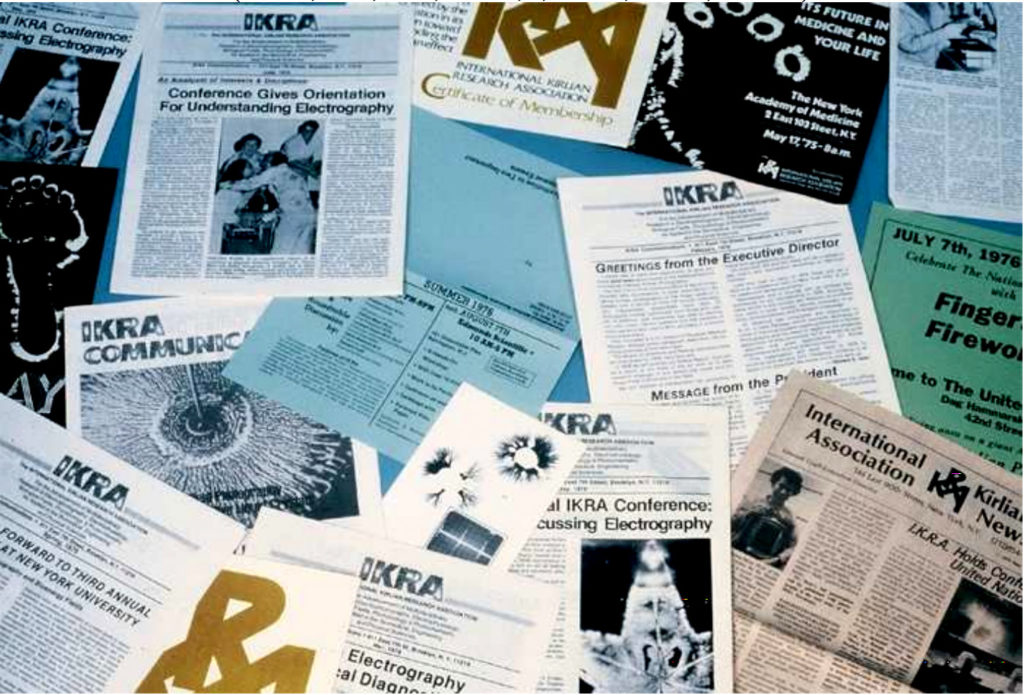IKRA
The International Kirlian Research Association
1974 scientists from different countries came together in an international association for the study of Kirlian effect (The International Kirlian Research Association, IKRA) (Drexel University).
The organization was formed in December 1974 at a seminar in the Community Hospital in Brooklyn, NY for the purpose of standardization and assistance at all stages of research into the Kirlian phenomenon.
Dr. Benjamin Shafiroff, New York College of Medicine, USA President of the Association IKRA.
The first members of the association are:
-I. Dumitrescu M.D. (Bucharest, Romania), +
-D. Faust (Philadelphia, Pennsylvania), +
-A. Hulstrunk, M.S. (Rexford, New York),
-L. Konikiewicz M.A.R.B.P. (Harrisburg, Pennsylvania), +
-L. Kuriger (Phoenix, Arizona),
-E. Lantz (Miami, Florida),
-K. Libraty (Brooklyn, New York),
–T. Moss (Los Anheles, California), +
-K. Schoss (New York, New York),
-T. Upton (Monrobia, California). +
Published the journal Acta Electrophotographica (Official Journal of International Kirlian Research Association, published in Romania)

IKRA Newsletter, (1976)
IKRA Communication (1978-5, 1981, 1982, 1983-7, 8, 1984-4, 1985-5, 1986-12).
1975-18 may, Ney York. The first workshop, 400 participants.
1975-Conference on Kirlian Phenomena. Sponsors of the Congress Department of Physics and
Atmosperic Science
1979-3 th International Conference of IKRA. Harrisburg. Pennsylvania. USA. 1979.
1980-4 Annual Conference of the International Association of Research Kirlian effect, in June 1980.
Omura Yoshiaki International Kirlian Research Association (IKRA),
1975-Chairman of International Standards Committee, May.
1980-Vice president of IKRA.
1973-Uchida H., A method of detecting aura phenomena. IKRA Communication. 1973.
1976-Omura, Yoshiaki: International standards for Kirlian photography research. IKRA (International
Kirlian Research Association) Newsletter, 1976, p.4.
1976-Omura, Yoshiaki: IKRA 24 point research guidelines. Acupuncture and Electrotherapeutics
Research: The International Journal, V.2, No.1 / 2 (1976/77), p.45 and 61-62.
1978-Graff E. Kirlian electrography as a clinical diagnostic tool. IKRA Communications, 411 East 7th
St. Brooklyn, N.Y. 11218, Mar 1978.
1978- Wagner R. “The Ghost Effect”, IKRA Communications (Brooklyn, NY International Kirlian
Research Association, June. 1978).
1979-Telma Moss. Kirlian Photography As An Art & Science. IKRA. 1979.
1979-Mallikarjun S. Kirlian photography and the detecting of Cancer. IKRA conference. 1979. New
York. p.1-2.
1981-Shafiroff B. The validity of electrography of the fingertip. IKRA Communication, 1981.
1982-Manganas V., “Corona discharge photography in psychistry”. Zachariades N., Komunikat IKRA,
1983-Steiner L.R., Bio-energy photography. IKRA Communication. 7.8 / 1983
1984-Moss T., Fingertips of subject who had taken marijuana. Kom. IKRA 4/1984.
1985-Steiner L., The dr. Lee Steiner collection of Kirlian electrographs. IKRA Communications.
1985-IKRA Communication. “Notes of scientific interest for Kirlian Researchers”. 1985. 5/85.
1986-Wilczewski J., The electrograph of the leaf before and after partical amputation. IKRA
Communication. 12/1986.
Founded in 1975 with a membership of physicists, electrical engineers, psychologists, parapsychologists, physicians, graduate science students, interested individuals with advanced degrees, and those engaged in scientific research. The association hoped to advance research on Kirlian photography (electrography) through multidisciplinary research or electromagnetic interactions in biological and medical functions.
Kirlian photography is named for its inventor, Semyon Kirlian, a Russian electrical engineer who developed a technique of photographing objects without the use of cameras through a high-voltage, high-frequency, low-amperage electrical discharge, thus showing an aura around objects. The Kirlian aura was frequently identified as the aura reportedly seen around individuals by psychics and that was seen by Walter J. Kilner through various optical effects.
The work of the association was blunted in the early 1980s by a negative laboratory opinion on the more interesting Kirlian effects that suggested they were caused by flawed experimental controls. The association maintains a speakers bureau and publishes Communications and Acta Electragrafica quarterly. Address: 2202 Quentin Rd., Brooklyn, NY 11229.
